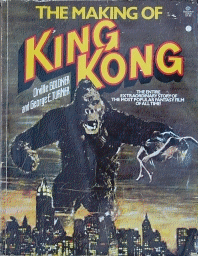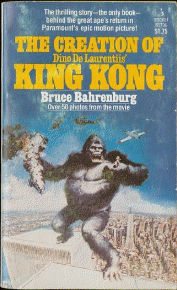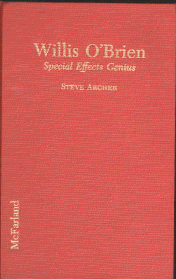|
Find interviews by: | ||
King Kong in Print (Part 2) Return to part one of this article, which was first published in Book and Magazine Collector in 2003, or go to the King Kong bibliography.
Published by AS Barnes & Co in hardback, and by Ballantine in softback in 1976, The Making of King Kong was for many years the centrepiece of any Kong fan’s bookshelf. Prices have come down in the past year or two because of a recent updated edition, but it is still a beautiful and collectible book. The rarest version by far is the 1975 British hardback from Tantivy Press, which still sells for £40-£50. An essential companion volume is The Girl in the Hairy Paw, a collection of Kong ephemera edited by Ronald Gottesman and Harry Geduld and published in a softback edition by Flare, an imprint of Avon Books, in 1976. Occasionally pretentious, this book is nevertheless a treasure trove, including original 1933 reviews, posters and adverts; articles from Cahiers du Cinema, The Monster Times, and other film magazines; Philip José Farmer’s award-winning (and much anthologised) story ‘After King Kong Fell’; reminiscences by Fay Wray, Obie and others; amazing behind-the-scenes photographs; and even Bob Newhart’s Kong-inspired monologue ‘The Nightwatchman.’ The book is long out of print but fortunately still reasonably easy to locate and affordable, which is more than can be said for the ‘King Kong Special’ edition of Midi-Minuit Fantastique (October/November 1962) from where a couple of the articles are taken. This amazing French magazine now sells for £40-£50, offering as it does the only pre-1970s look at the Kong phenomenon. The De Laurentiis remake was ballyhooed as the greatest monster movie of all time, but of course was swiftly discovered, when people had a chance to see it, to be a classic turkey. A giant lifesize Kong had been built and was heavily featured in publicity, but it proved to be a giant embarrassment and was only used in a couple of scenes, so for the most part the ape was played by special effects man Rick Baker in a gorilla suit not much more advanced or realistic than the one used in King Kong Vs Godzilla. A vast array of King Kong tie-in merchandise was produced, almost as much as appeared the following year for Star Wars. Board games, lunchboxes, jigsaws, stickers... the list was endless, and most off this material is still relatively easy to pick up today, as are promotional paper items such as posters and lobby cards from around the world.
The King Kong Story was a surprisingly well-written slim volume published in hardback in the USA and in softback in the UK. Covering both the original and remake, as well as rip-offs like Konga, the text was credited (if one looked closely) to Jeremy Pascall, and there was a reasonable selection of images, some of which had not made it into the Goldner/Turner book or The Girl in the Hairy Paw. The similarly titled King Kong Story by René Chateau (with Marielle de Lesseps and the collaboration of Jean-Claude Romer and Forrest J Ackerman) was a different look at the whole Kong phenomenon, with particular emphasis on gorillas in comic-books and on the sexual aspect of the story. Published in paperback by Éditions Rene Chateau in 1977 (in French) this has never been translated but remains an interesting and hard to find item for the Kong bibliophile. An even more wide-ranging (but rather scrappily compiled) look at gorilla movies was Ape by David Annan, subtitled Monster of the Movies in its American hardback edition from Bounty Books and The Kingdom of Kong in its UK softback edition from Lorrimer. The truly extraordinary Queen Kong by James Moffat is, possibly uniquely, a novelisation of a film that was never released. This Anglo-Italian ‘comedy’ starred Rula Lenska and Robin Askwith (as Ray Fay!) in a cheesy role-reversal spoof of both the original and the remake. De Laurentiis took exception to this and the case was eventually settled out of court. For the next 25 years, all that was known about Queen Kong came from this paperback and the photos within it, but the film finally saw the light of day on DVD this year. Whether it was worth the wait is another matter... A much funnier spoof was My Side by King Kong (‘as told to Walter Wager’), an autobiography by the giant ape which reveals, among other things, that the so-called ‘Skull Island natives’ were actually a shipwrecked touring company of Porgy and Bess! Amok: King of Legend by Bernard L Ross was a rather thinly disguised clone of the King Kong story published by Futura to cash in on the De Laurentiis film, which was actually pseudonymous hackwork by the young Ken Follett. But this was nothing new: giant apes, isolated Pacific islands and roaming dinosaurs are all public domain concepts and such copyright-skirting stories extend back at least as far as the completely shameless Kong clone The Hurricane Kids on the Lost Islands (1941) by Oskar Lebeck and Gaylord Dubois. In 1978, Michel Parry demonstrated the panoply of Kong-esque fantastic literature by collecting eleven such stories in The Rivals of King Kong: A Rampage of Beasts. As well as Farmer’s ‘After King Kong Fell,’ there were stories by Robert Silverberg, Henry Kuttner, Hugh B Cave, Karl Edward Wagner and an extract from the 1914 Rider Haggard novel Allan and the Holy Flower. In 1988 another ever-reliable anthologist, Peter Haining, collected some short stories and novellas which had inspired classic monster films in a collection entitled Movie Monsters. Among his discoveries was another contemporary adaptation of King Kong: published in the 28th October 1933 edition of Cinema Weekly, this novella was credited to Edgar Wallace and Draycott M Dell. Research shows that Draycott Montagu Dell (1888-1940) was a prolific, author of children’s fiction throughout the 1920s and ‘30s, under both his own name and a variety of pseudonyms: Piers Anson, Paul Corydon (sic), Rodney Holland, Mary Ellen Shirley and Joan Inglesant. His other works include Dough-Nuts for the Dough-Boys (1917), a collection of jokes for GIs stationed in Britain, and The Wicked King: A Child’s History of the Great War (1926)! Haining’s collection is worth owning for the ‘King Kong’ novella alone. Fay Wray’s brilliantly titled autobiography On the Other Hand was published in 1989 (and in the UK the following year). An immensely readable account of a remarkable career, which of course extended far beyond King Kong, this is an essential purchase for any fan of the movie. Far more obscure is an index of the Merian C Cooper collection of papers held by the Harold B Lee Library at Brigham Young University. This limited edition softcover also includes a 24-page biography of Cooper by Rudy Behlmer. Another university press, Wayne State, published Cynthia Erb’s Tracking King Kong: A Hollywood Icon in World Culture, an interesting academic look at the extended influence of the movie and its central character.
The Lovelace novelisation was retold twice in 1977: by Judith Hatch as The Story Behind King Kong, and by Ian Thorne for Crestwood House’s ‘Monsters’ series of movie adaptations. Judith Conaway wrote a version in 1983 for Random House, with illustrations by Paul Berenstain, which was republished in 1988 with illustrations by Paul Van Munching. The most lavish version was by illustrator Anthony Browne, an oversize hardback published as Anthony Browne’s King Kong (with no credit for Lovelace). There was also an authorised six-issue comic-book adaptation of the movie by Don Simpson in 1991 from Fantagraphics. Last year saw a long-awaited revised update of Goldner and Turner’s classic The Making of King Kong from Midnight Marquee’s Luminary Press imprint, retitled Spawn of Skull Island. Turner’s son Douglas and Michael H Price (who co-wrote several books with Turner Sr) collaborated on the updates, which included adding further information on the film that has come to light since 1975, enhancing the photographs, and adding chapters on other Kong-related films (including a piece on Mighty Joe Young which was dropped from the original book). Introductions by Ray Harryhausen and Ray Bradbury make this version particularly attractive to collectors. In fact, George Turner amassed so much information on King Kong and those who made it that even this updated edition can only scratch the surface. Douglas Turner could have donated his father’s collection in toto to a library or museum, but has instead very generously decided to make it widely available in a bimonthly publication, George Turner’s Treasures of Skull Island. Mixing unseen drawings and photographs with lengthy archive interviews and original scripts and treatments, this really is the ultimate for King Kong fans. It’s not cheap ($15 an issue, $72 for a six-issue subscription) but that reflects the specialist appeal of the material; Turner certainly isn’t making a living out of it. Nor is he carelessly throwing together anything he comes across; each issue of Treasures is well-written, edited and laid out. A companion publication, showcasing digitally restored photographs from the collection, is George Turner’s Skull Island Photo Album ($18; six-issue sub $90). Creation: The Art of an Epic Volume 1 ($18) compiles production art and storyboards from that abandoned production, and Turner has also collected some material onto a CD-ROM, George Turner’s Kongofiles Volume 1, which includes a complete look at that amazing copper-covered Hollywood Reporter supplement. Douglas Turner can be contacted at 10531 Greenburn Avenue, Sunland CA 91040, USA or www.sculptureone.com/kong. Finally, we come full circle. Later this year Dark Horse Entertainment will publish an illustrated prequel/sequel to the original film, entitled Skull Island. Written by Kong expert John Michlig (who is also working on what may be the definitive Kong companion, tentatively scheduled for 2004), this is the first ever piece of King Kong fiction authorised by the Merian C Cooper estate. [Michlig's 'definitive Kong companion never appeared although, as of January 2006, he is working on a book entitled Eighth Wonder: The Amazing True Story of Carl Denham and the Beast-God of Skull Island. - MJS] Rarely has there been a film about which so much has been documented and discussed, but that is because rarely has there been a film like King Kong. It really is, as the RKO publicity department claimed 70 years ago, the eighth wonder of the world. Return to part one of this article or go to the bibliography. | ||



